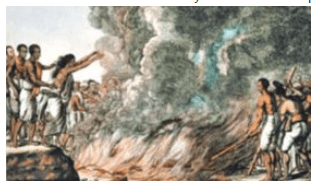Test: Women Caste & Reform - 1 - UPSC MCQ
10 Questions MCQ Test Old & New NCERTs for IAS Preparation (Must Read) - Test: Women Caste & Reform - 1
Painted by a European artist who came to India, this was one of the many pictures of a religious practice, a social evil that existed in ancient India. Identify the name of the practice

Name the uppermost caste in the social ladder that existed in ancient India
Among the following, which class belonged to the traders and money lenders
Name the class that belonged to the lower most strata in the social ladder of ancient India
With respect to ancient India, a list of statements related to the untouchables are given below. Point out the one that is not TRUE.
An image of a popular reformer who founded a reform association Brahmo Samaj is given below. Name this personality.
Who has been referred as the Prophet of Indian Nationalism?
Under which Governor General did Raja Ram Mohan Roy initiative to ban Sati?
Who was particularly moved by the problems widows faced in their lives and began a campaign against the practice of sati?
|
3 videos|729 docs|527 tests
|
|
3 videos|729 docs|527 tests
|














